Mises, Ludwig von. Human Action: A Treatise on Economics
Подождите немного. Документ загружается.

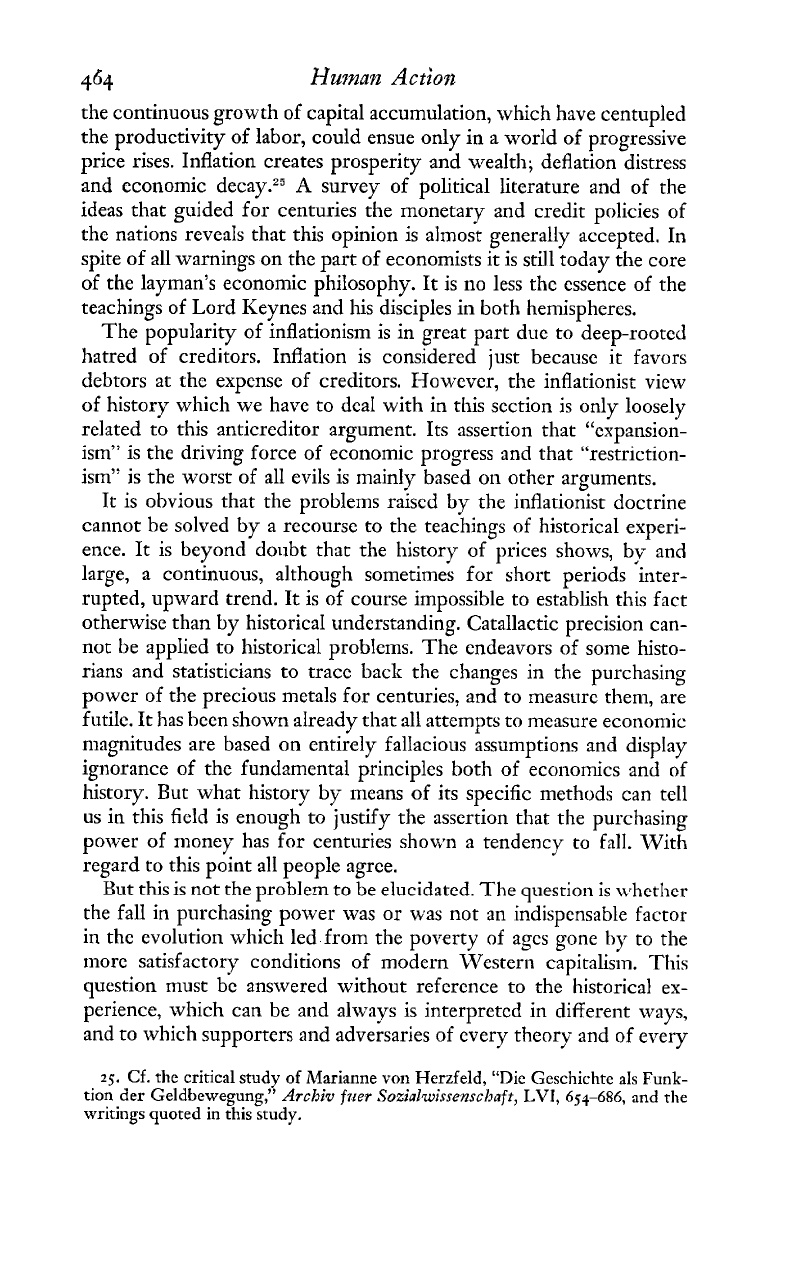
464
Human
Action
the continuous growth of capital accumulation, which have centupled
the productivity of labor, could ensue only
in
a
world of progressive
price rises. Inflation creates prosperity and wealth; deflation distress
and economic decay.25
A
survey of political literature and of the
ideas that guided for centuries the monetary and credit policies of
the nations reveals that this opinion is almost generally accepted. In
spite of all warnings on the part of economists it is still today the core
of the layman's economic philosophy. It is no less the essence of the
teachings of Lord Keynes and his disciples in both hemispheres.
The popularity of inflationism is in great part due to deep-rooted
hatred of creditors. Inflation is considered just because it favors
debtors at the expense of creditors. However, the inflationist view
of history which we have to deaI with in this section is only loosely
related to this anticreditor argument. Its assertion that "expansion-
ism" is the driving force of economic progress and that "restriction-
ism" is the worst of all evils is mainly based on other arguments.
Jt
is obvious that the problems raised by the inflationist doctrine
cannot he solved by a recourse to the teachings of historical experi-
ence. It is beyond doubt that the history of prices shows, by and
large,
a
continuous, although sometimes for short periods inter-
rupted, upward trend. It is of course impossible to establish this fact
otherwise than by historica1 understanding. Catallactic precision can-
not
be
applied to historical problems. The endeavors of some histo-
rians and statisticians to trace back the changes in the purchasing
power of the precious metals for centuries, and to measure them, are
futile. It has been shown already that all attempts to measure economic
nlagnitudes are based on entirely falIacious assumptions and display
ignorance of the fundamental principles both of economics and of
history. But what history
by
means of its specific methods can tell
us in this field is enough to justify the assertion that the purchasing
power of money has for centuries shown a tendency to fall. With
regard to this point all people agree.
Hut
this is
not
the
proh!err?
tc!
be e!ucidatcd.
T!x
ql~esda!~
is
v+et!?er
the fall in purchasing power was or was not an indispensable factor
in the evolution which led from the poverty of ages gone hy to the
more satisfactory conditions of modern Western capitalism. This
question must bc answered without reference to the historical ex-
perience, which can be and always is interpreted in different ways,
and to which supporters and adversaries of every theory and of every
25.
Cf.
the critical study
of
Marianne
von
Herzfeld, "Die Geschichtc als
Funk-
tion der Geldbewegung,"
Archiv
frier
Sozialwissenscbaft,
LVI,
654-686,
and the
writings quoted in this study.
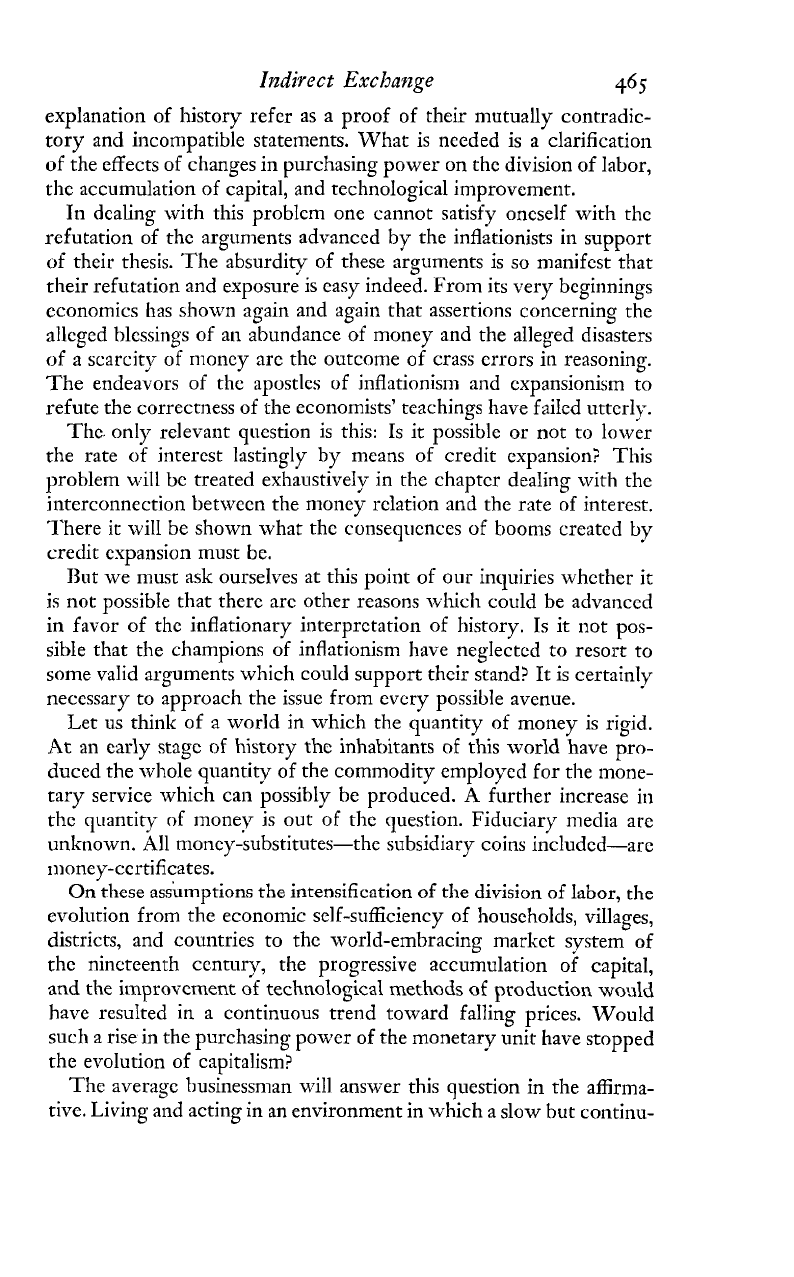
Indirect
Exchange
465
explanation of history refer as
a
proof of their mutually contradic-
tory and incompatible statements. What is needed is a clarification
of the effects of changes in purchasing power on the division of labor,
the accumulation of capital, and tecl~nological improvement.
In dealing with this problem one cannot satisfy oneself with the
refutation of the arguments advanced by the inflationists in support
of their thesis. The absurdity of these arguments
is
so manifest that
their refutation and exposure is easy indeed. From its very beginnings
economics has shown again and again that assertions concerning the
alleged blessings of an abundance of money and the alleged disasters
of
a scarcity of money are the outcome of crass errors in reasoning.
The endeavors of the apostles of inflationism and expansionism to
refute the correctness of the
economists'
teachings have failed utterly.
The only relevant question is this: Is it possible or not to lower
the rate of interest lastingly by means of credit expansion? This
problem will be treated exhaustively in the chapter dealing with the
jnterconnection between the money relation and the rate of interest.
There it wilI be shown whar the consequences of booms created by
credit expansion must be.
13ut we must: ask ourselves at this point of our inquiries whether it
is
not
possibIe that there are other reasons which could be advanced
in favor of the inflationary interpretation of history. Is it not pos-
sible that the champions of inflationism have neglected to resort to
some valid arguments which could support their stand? It is certainly
necessary to approach the issue from every possible avcnue.
Let us think of a world in which the quantity of money is rigid.
At an early stage
of
history the inhasitants of this world have pro-
duced the whole quantity of the commodity employed for the mone-
tary service which can possibly be produced.
A
further increase in
the quantity of money is out of the question. Fiduciary media are
unknown. All money-substitutes-the subsidiary coins included-are
money-certificates.
On these assumptions the intensification
of
the division of labor, the
evolution from the economic self-sufficiency of ho~iseholds, villages,
districts, and countries to the world-embracing market system of
the nineteenth century, the progressive accumulation of capital,
and
the itnprovement of technological methods
of
production
wonld
have resdted in a continuous trend toward falling prices. Would
such
a
rise in the purchasing power of the monetary unit have stopped
the evolution of capitalism?
The average businessn~an will answer this question
in
the affirma-
tive. Living and acting in an environment in which a slow but continu-
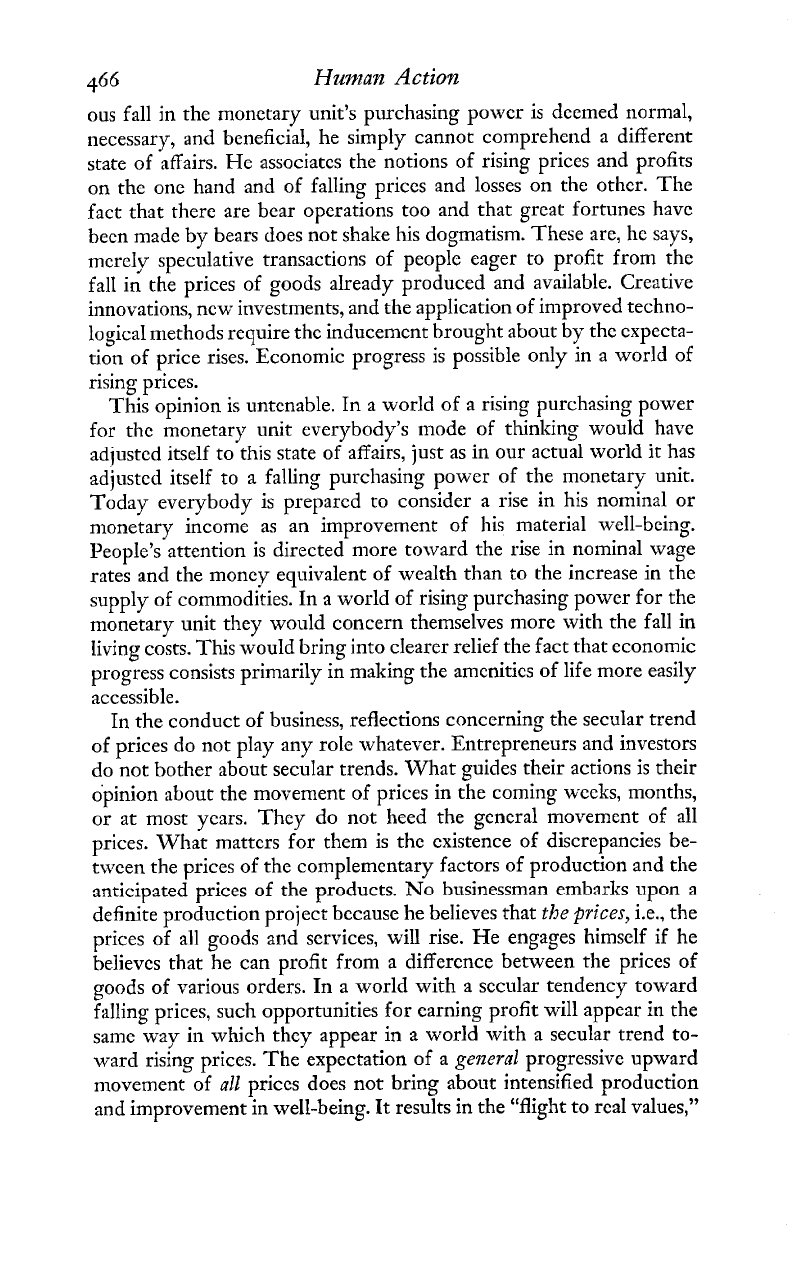
466
Hzman
Action
ous fall in the monctary unit's purchasing power is deemed normal,
necessary, and beneficial, he simply cannot comprehend a different
state of affairs.
He
associates the notions of rising prices and profits
on the one hand and of falling prices and losses on the other. The
fact that there are bear operations too and that great fortunes have
been made by bears does not shake his dogmatism. These are, he says,
merely speculative transactions of people eager to profit from the
fa11 in the prices of goods already produced and available. Creative
innovations, new investments, and the application of improved techno-
logical methods require the inducement brought about by the expecta-
tion of price rises. Economic progress is possible only in a world of
rising prices.
This opinion is untenable. In a world of a rising purchasing power
for the monetary unit everybody's mode of thinking would have
adjusted itself to this state of affairs, just as in our actual world it has
adjusted itself to a falling purchasing power of the monetary unit.
Today everybody is prepared to consider a rise in his nominal or
monetary income as an improvement of his material well-being.
People's attention is directed more toward the rise in nominal wage
rates and the money equivalent of wealth than to the increase in the
supply of commodities. In a world of rising purchasing power for the
monetary unit they would concern themselves more with the fall in
living costs. This would bring into clearer relief the fact that economic
progress consists primarily in making the amcnitics of life more easily
accessible.
In the conduct of business, reflections concerning the secular trend
of prices do not play any role whatever. Entrepreneurs and investors
do not bother about secular trends. What guides their actions is their
opinion about the movement of prices in the coming weeks, months,
or at most years. They do not heed the general movement of all
prices. What matters for them is the existence of discrepancies be-
tween the prices of the complementary factors of production and the
ar?ticipated
prices
nf
the
pmdum.
No
hnsinessmm emharks
unon
r
---
a
-
definite production project because he beIieves that
the
prices,
i.e., the
prices of all goods and services, will rise. He engages himself if he
believes that he can profit from a difference between the prices of
goods of various orders. In a world with a secular tendency toward
falling prices, such opportunities for earning profit will appear in the
same way in which they appear in
a
world with
a
secular trend to-
ward rising prices. The expectation of a
general
progressive upward
movement of
all
prices does not bring about intensified production
and improvement in well-being. It results in the "flight to real values,"
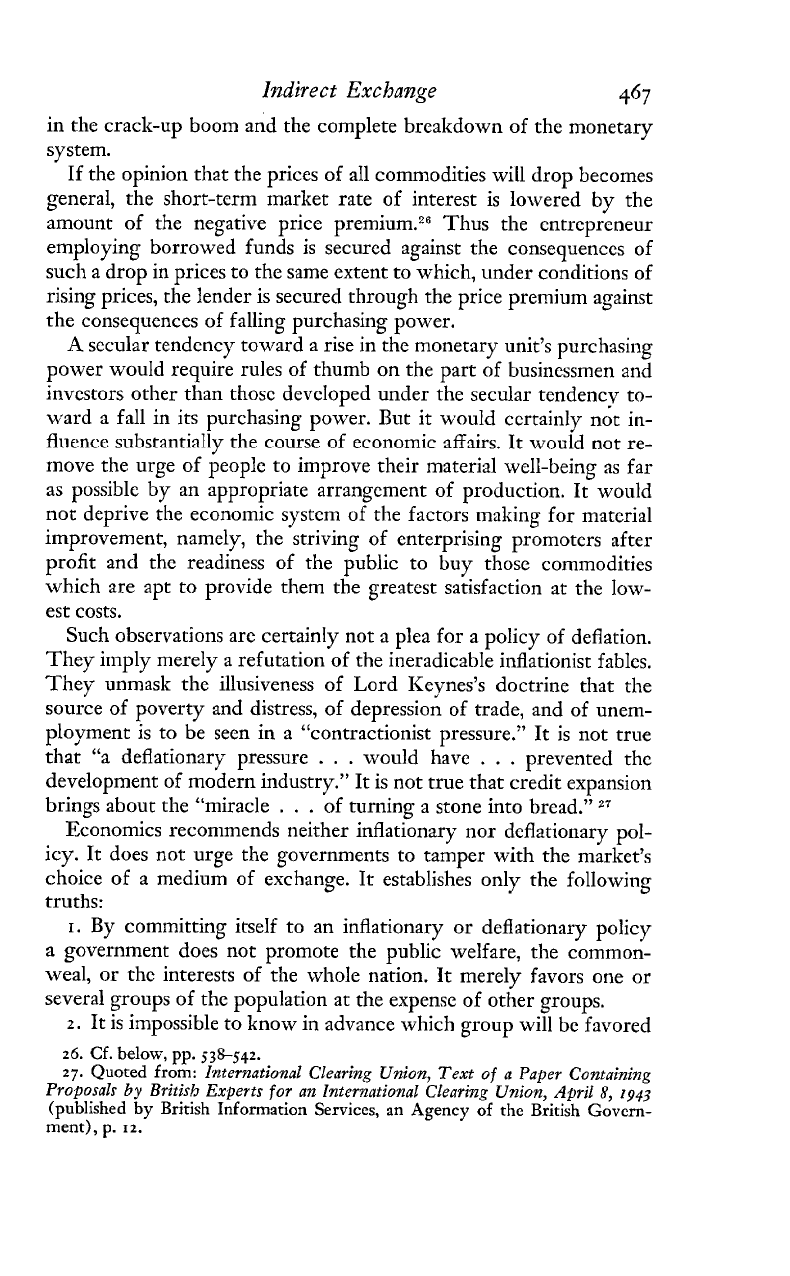
Indirect
Exchange
in the crack-up boom and the complete breakdown of the monetary
system.
If the opinion that the prices of a11 comnlodities will drop becomes
general, the short-term rnarket rate of interest is lowered by the
amount of the negative price premium." Thus the entrepreneur
employing borrowed funds is secured against the consequences of
such a drop in prices to the same extent to which, under conditions of
rising prices, the lender is secured through the price premium against
the consequences of falling purchasing power.
A
secular tendency toward a rise in the monetary unit's purchasing
pow-er would require rules of thumb on the part of businessmen and
investors other than those developed under the secular tendencv to-
ward a fall in its purchasing power. But it would certainly not in-
fluence substantially the course of economic affairs.
It
would not
re-
move the urge of people to improve their material well-being as far
as possible by an appropriate arrangement of production. It would
not deprive the economic system of the factors making for material
improvement, namely, the striving of enterprising promoters after
profit and the readiness of the public to buy those commodities
which are apt to provide them the greatest satisfaction at the low-
est costs.
Such observations arc certainly not a plea for a policy of deflation.
They imply merely a refutation of the ineradicable inflationist fables.
They unmask the illusiveness of Lord Keynes's doctrine that the
source of poverty and distress, of depression of trade, and of unem-
ployment is to be seen in a "contractionist pressure." It is not true
that "a deflationary pressure
.
. .
would have
.
.
.
prevented the
development of modern industry." It is not true that credit expansion
brings about the "n~iracle
.
.
.
of turning a stone into bread."
27
Economics recommends neither inflationary nor deflationary pol-
icy. It does not urge the governments to tamper with the market's
choice of a medium of exchange. It establishes only the following
truths:
I.
By committing itself to an inflationary or deflationary policy
a
government does not promote the public welfare, the common-
weal, or the interests of the whole nation. It merely favors one or
several groups of the population at the expense of other groups.
2.
It is impossible to know in advance which group will be favored
26.
Cf.
below, pp.
j38-542.
27.
Quoted from:
International Clearing Uni~a, Text of a Paper Containing
Proposals
by
British Experts for
a72
International Clearing Union, April
8,
1943
(published by British Information Services, an Agency
of
the British Govern-
ment),
p.
12.
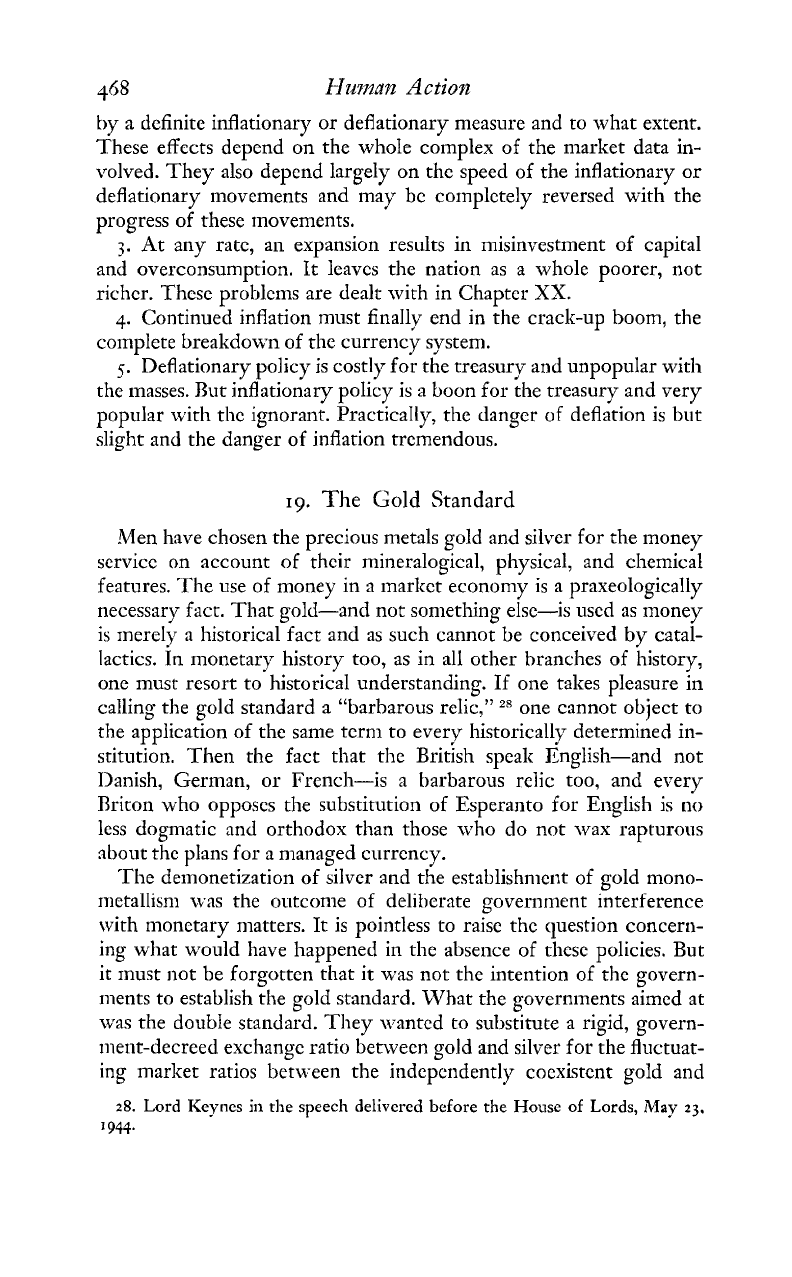
468
I-luman
Action
by a definite inflationary or deflationary measure and to what extent.
These effects depend on the whole complex of the market data
in-
volved. They also depend largely on the speed of the inflationary or
deflationary movements and may be
completely
reversed with the
progress of these movements.
3.
At
any rate, an expansion results in misinvestment of capital
and overconsumption. It leavcs the nation as a whole poorer, not
richer. These problcms are dealt with in Chapter
XX.
4.
Continued inflation must finally end in the crack-up boom, the
complete breakdown of the currency system.
5.
Deflationary policy is costly for the treasury and unpopular with
the masses. Rut inflationary policy is a boon for the treasury and very
popular with thc ignorant. PracticaIly, the danger of deflation is but
slight and the danger of inflation tremendous.
19.
The
Gold Standard
Men have chosen the precious metals gold and silver for the money
service
on
account of thcir mineralogical, physical, and chemical
features. The use of money in a market economy is a praxeologically
necessary fact. That gold-and not something else-is used as money
is merely a historical fact and as such cannot be conceived by catal-
lactics. In monetary history too, as in all other branches of history,
one must resort to'historical understanding. If one takes pleasure in
calling the gold standard
a
"barbarous relic,"
28
one cannot object to
the application of the same tern1 to every historically determined in-
stitution. Then the fact that the British speak English-and not
Danish, German, or French-is a barbarous relic too, and every
Rricon who opposes the substitution of Esperanto for English is
no
less dogmatic and orthodox than those who do not wax rapturous
about the plans for a managed currency.
The demonetization of silver and the establishment of gold mono-
rr~ctallisnl was the outcome of delibcrate government interference
with monetary matters.
It
is pointless to raise the question concern-
ing what would have happened in the absence of these policies. But
it must not be forgotten that it was not the intention of the govern-
ments to establish the gold standard. What the governments aimed at
was the double standard. They wanted to substitute a rigid, govern-
ment-decreed exchange ratio between gold and silver for the fluctuat-
ing market ratios betu-een the independently cocxktent gold and
28.
Lord Keynes
in
the speech delivered before the
House
of Lords,
may
23.
'944
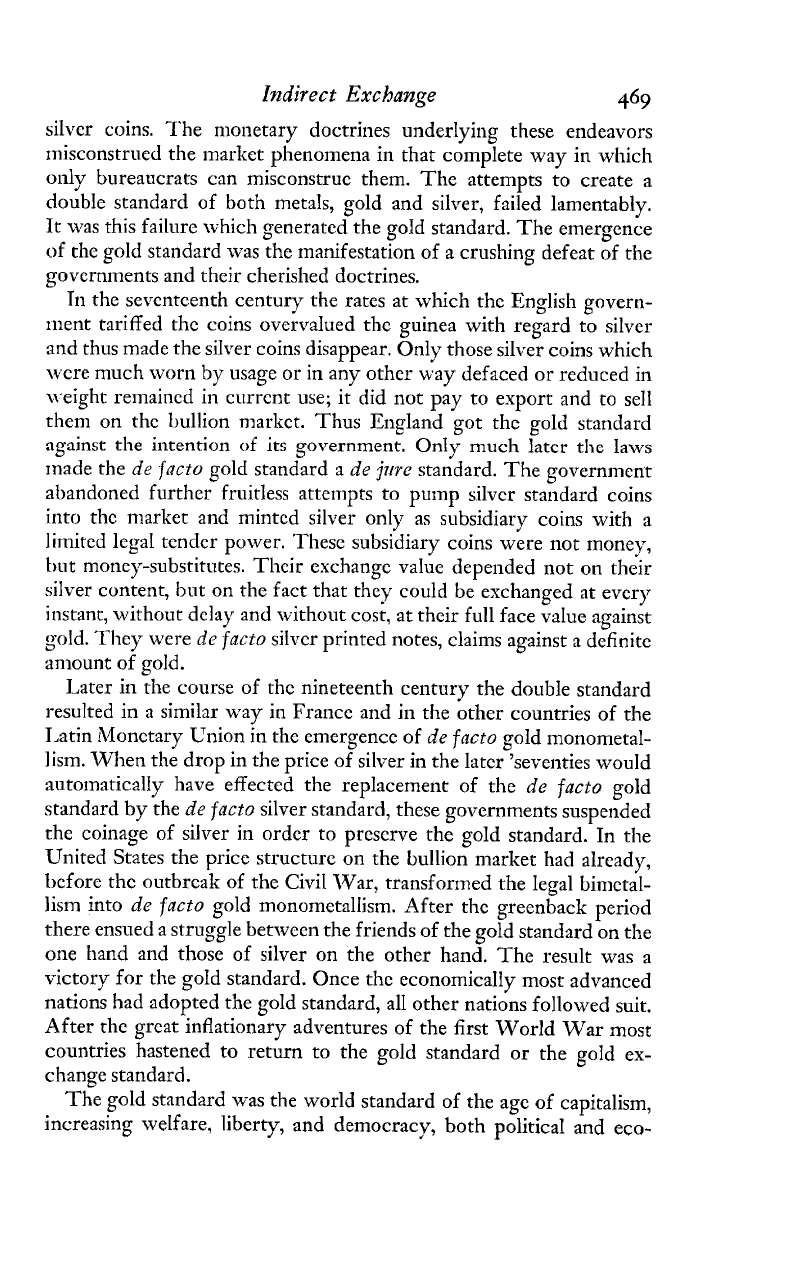
Indirect
Exchange
469
silver coins. The monetary doctrines underlying these endeavors
~nisconstrued the market phenomena in that complete way in which
only bureaucrats can misconstrue them. The attempts to create a
double standard of both metals, gold and silver, failed lamentably.
It was this failure which generated the gold standard. The emergence
of the gold standard was the ~nanifestation of a crushing defeat of the
governments and their cherished doctrines.
In the seventeenth century the rates at which the English govern-
ment tariffed the coins overvalued the guinea with regard to silver
and thus made the siIver coins disappear. Only those silver coins which
were much worn by usage or in any other way defaced or reduced in
n.eight remained in current use; it did not pay to export and to sell
then1 on the 1)ullion market. Thus England got the gold standard
against the intention
of
its
government. Only much later the laws
made the
de
fncto
gold standard a
de
jrwe
standard. The government
abandoned further fruitless attempts to pump silvcr standard coins
into the market and minted silver only as subsidiary coins with a
limited legal tcnclcr power. These subsidiary coins were not money,
hut money-substitutes. Their exchange value depended not on their
silver content, but on the fact that they could be exchanged
at
every
instant, without dclay and without cos;, at thcir full face value against
gold. They were
dc
facto
silvcr printed notes, claims against a definite
amount of gold.
Later in the course of the nineteenth century the double standard
resulted in
a
similar way in France and in the other countries of the
1,atin iMonctary Union in the emergence of
de
facto
gold monometal-
I
ism. When the drop in the price of silver in the latcr 'seventies would
autornaticalIy have effected the replacement of the
de
facto
gold
standard
by
the
de
facto
silver standard, these governments suspended
the coinage of silver in ordcr to preserve the gold standard. In the
United States the price structure on the bullion market had already,
before the outbreak of the Civil War, transformed rhe legal bimetal-
lism into
de
facto
gold monometallism. After the greengack period
there ensued a struggle between the friends of the gold standard on the
one hand and those of silver on the other hand. The result was a
victory for the gold standard. Once the economically most advanced
nations had adopted the gold standard, all other nations followed suit.
After the grcat inflationary adventures of the first World War most
countries hastened to return to the gold standard or the gold ex-
change standard.
The gold standard was the world standard of the age of capitalism,
increasing welfare, liberty, and democracy, both political and eco-
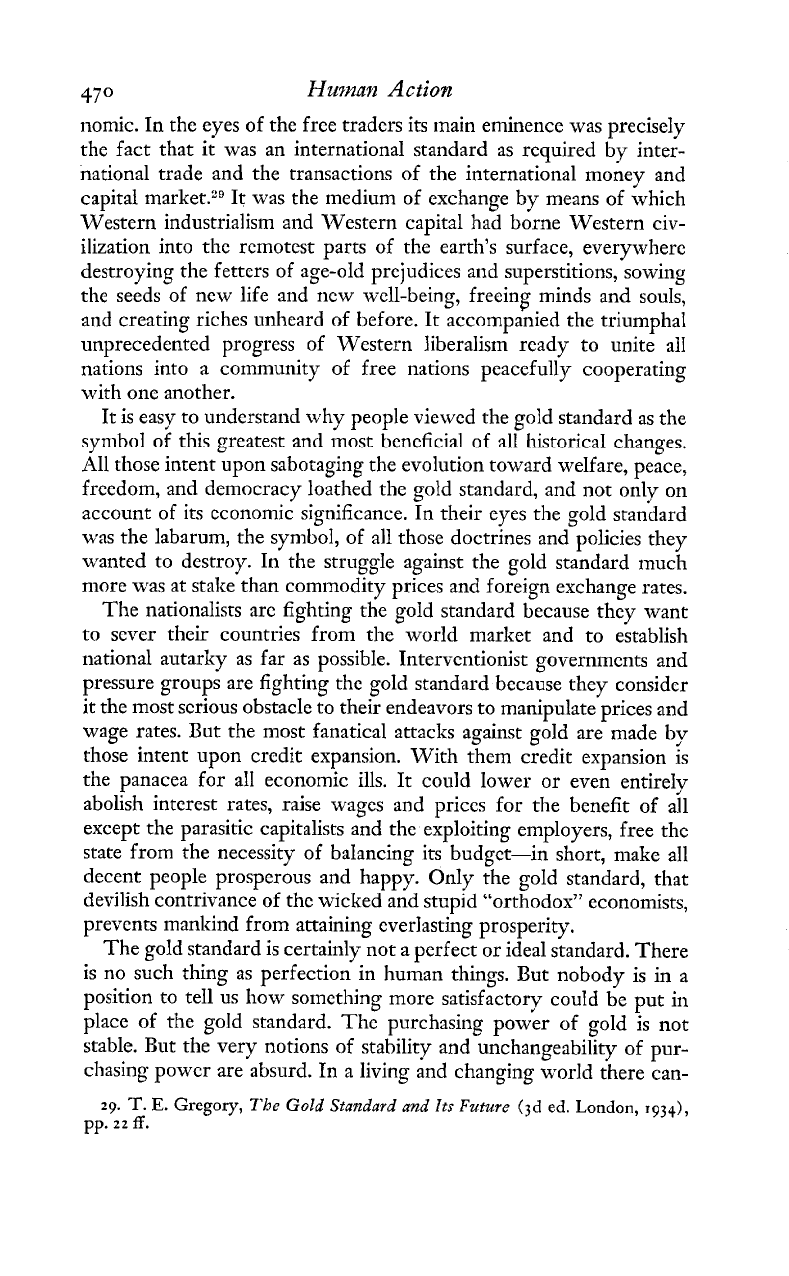
47O
Human
Action
nomic. In the eyes of the free tradcrs its main eminence was precisely
the fact that it was an international standard as rcquired by inter-
national trade and the transactions of the international money and
capital market." It was the medium of exchange by means of which
Western industrialism and Western capital had borne Western civ-
ilization into the remotest parts of the earth's surface, everywhere
destroying the fetters of age-old prejudices and superstitions, sowing
the seeds of new life and new well-being, frecing minds and souls,
and creating riches unheard of before. It accompanied the triumphal
unprecedented progress of Western liberalism rcady to unite all
nations into
a
community of free nations peacefully cooperating
with one another.
It is easy to understand why people viewed the gold standard as the
symbol of this greatest and most bencficial of all historical changes.
1111 those intent upon sabotaging the evolution toward welfare, peace,
frccdom, and democracy loathed the gold standard, and not only on
account of its cconornic significance. In their eyes the gold standard
was the labarum, the symbol, of all those doctrines and policies they
wanted to destroy. In the struggle against the gold standard much
more was at stake than commodity prices and foreign exchange rates.
The nationalists arc fighting the gold standard because they want
to sever their countries from the world
market and to establish
national autarky as far as possible. Intervcntionist governmcnts and
pressure groups are fighting the gold standard because they consider
it the most scrious obstacle to their endeavors to manipulate prices and
wage rates. But the most fanatical attacks against gold are made
by
those intent upon crcdit expansion. With them credit expansion is
the panacea for all economic ills. It could lower or even entirely
abolish interest rates, raise wages and prices for the benefit of all
except the parasitic capitalists and the exploiting employers, free the
state from the necessity of balancing its budget-in short, make all
decent people prosperous and happy. Only the gold standard, that
deviiifh contrivance of the wicked and stupid "orthodox" economists,
prevents mankind from attaining everlasting prosperity.
The gold standard is certainly not a perfect or ideal standard. There
is no such thing as perfection in human things. But nobody is in a
position to tell us how something more satisfactory couId be put in
place of the gold standard. The purchasing power of gold is not
stable. Rut the very notions of stability and unchangeability of pur-
chasing power are absurd. In a living and changing world there can-
29.
T.
E.
Gregory,
The
Gold
Standard
and
Its
Future
(3d ed. London,
1934),
pp.
22
ff.
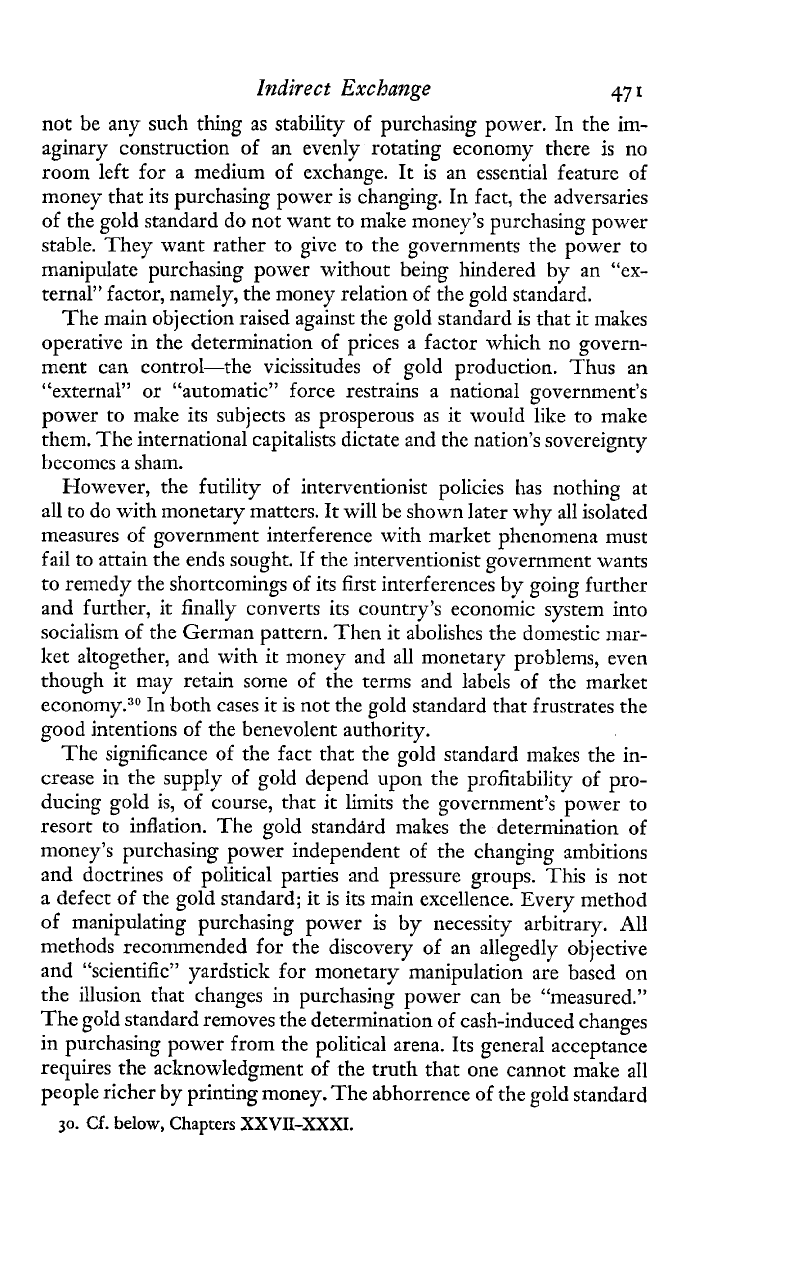
lndirect
Exchange
471
not be any such thing as stability of purchasing power. In the im-
aginary construction of an evenly rotating economy thcre is no
room left for a medium of exchange. It is an essential feature of
money that its purchasing pourer is changing. In fact, the adversaries
of the gold standard do not want to make money's purchasing power
stable. They want rather to give to the governments the power to
manipulate purchasing power without being hindered by an "ex-
ternal" factor, namely, the money relation of the gold standard.
The main objection raised against the gold standard is that it makes
operative in the determination of prices a factor which no govern-
ment can control-the vicissitudes of gold production. Thus an
"external" or "automatic" force restrains a national government's
power to make its subjects as prosperous as it would like to make
them. The international capitalists dictate and the nation's sovereignty
becomes a sham.
However, the futility of interventionist policies has nothing at
all to do with monetary matters. It will be shown later why all isolated
measures of government interference with market phenomena must
fail to attain the ends sought. If the interventionist government wants
to remedy the shortcomings of its first interferences by going further
and further, it finally converts its country's economic system into
socialism of the German pattern. Then it abolishes the domestic mar-
ket altogether, and with
it
money and all monetary problems, even
though it may retain some of the terms and labels of the market
economy.30 In both cases it is not the gold standard that frustrates the
good intentions of the benevolent authority.
The significance of the fact that the gold standard makes the in-
crease in the supply of gold depend upon the profitability of pro-
ducing gold is,
of
course, that
it
limits the govcrnment7s power to
resort to inflation. The gold standard makes the determination of
money's purchasing power independent of the changing ambitions
and doctrines of political parties and pressure groups. This is not
a
defect of the goid standard; it is its main exceiience. Every method
of manipulating purchasing power is by necessity arbitrary.
All
methods recommended for the discovery of an allegedly objective
and "scientific" yardstick for monetary manipulation are based on
the illusion that changes in purchasing power can be "measured."
The goId standard removes the determination of cash-induced changes
in purchasing power from the political arena. Its general acceptance
requires the acknowledgment
of
the truth that one cannot make a11
people richer by printing money. The abhorrence of the gold standard
30.
Cf.
below,
Chapters
XXVII-XXXI.
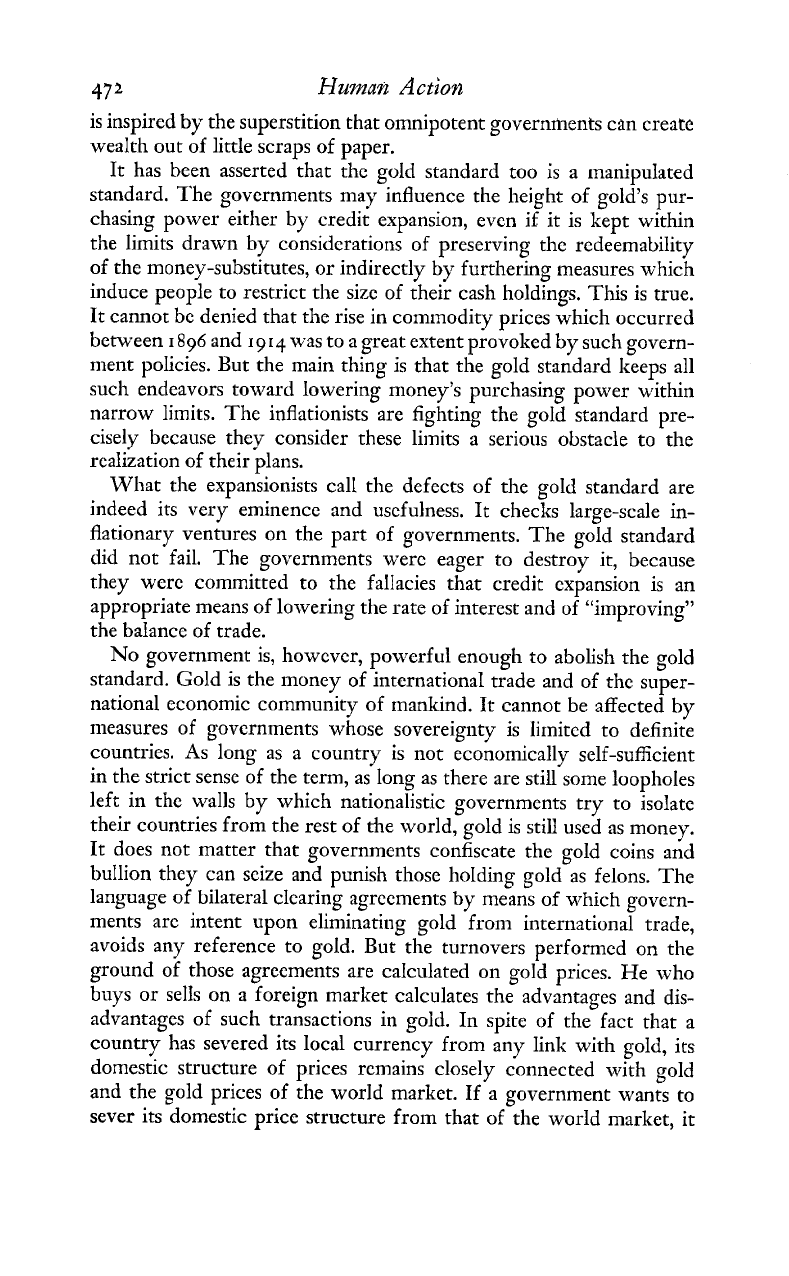
472
Human
Action
is inspired by the superstition that omnipotent governments can create
wealth out of little scraps of paper.
It has been asserted that the gold standard too is a manipulated
standard. The governments may influence the height of gold's pur-
chasing power either by credi; expansion, even if it is kept within
the limits drawn by considerations of preserving the redeemability
of the money-substitutes, or indirectly by furthering measures which
induce people to restrict the size of their cash holdings. This is true.
It cannot be denied that the rise in commodity prices which occurred
between
I
896
and
1914
was to a great extent pEovolted by such govern-
ment policies. But the main thing is that the gold standard keeps all
such endeavors toward lowering money's purchasing power within
narrow limits. The inflationists are fighting the gold standard pre-
cisely because thev consider these limits a serious obstacle to the
realization of their plans.
What the expansionists call the defects of the gold standard are
indeed its very eminence and uscfulness. It checks large-scale in-
flationary ventures on the part of governments. The gold standard
did not fail. The governments were eager to destroy it, because
they were committed to the fallacies that credit expansion is an
appropriate means of lowering the rate of interest and of "improving"
the baIance of trade.
No government is, however, powerful enough to abolish the gold
standard. Gold is the money of international trade and of the super-
national economic community of ~nankind. It cannot be affected by
measures of governments whose sovereignty is limited to definite
countries. As long as a country is not economically self-sufficient
in the strict sense of the term, as long as there are still some loopholes
left in the walls by which nationalistic governments try to isolatc
their countries from the rest of the world, gold is still used as money.
It does not matter that governments confiscate the gold coins aGd
bullion they can seize and punish those holding gold as felons. The
language of biiarerai clearing agreements
by
means of which govern-
ments are intent upon eliminating gold from international trade,
avoids any reference to gold. But the turnovers performed on the
ground of those agreements are calculated on gold prices. He who
buys or sells on a foreign market calculates the advantages and dis-
advantages of such transactions in gold. In spite of the fact that a
country has severed its local currency from any link with gold, its
domestic structure of prices remains closely connected with gold
and the gold prices of the world market. If a government wants to
sever its domestic price structure from that of the world market, it
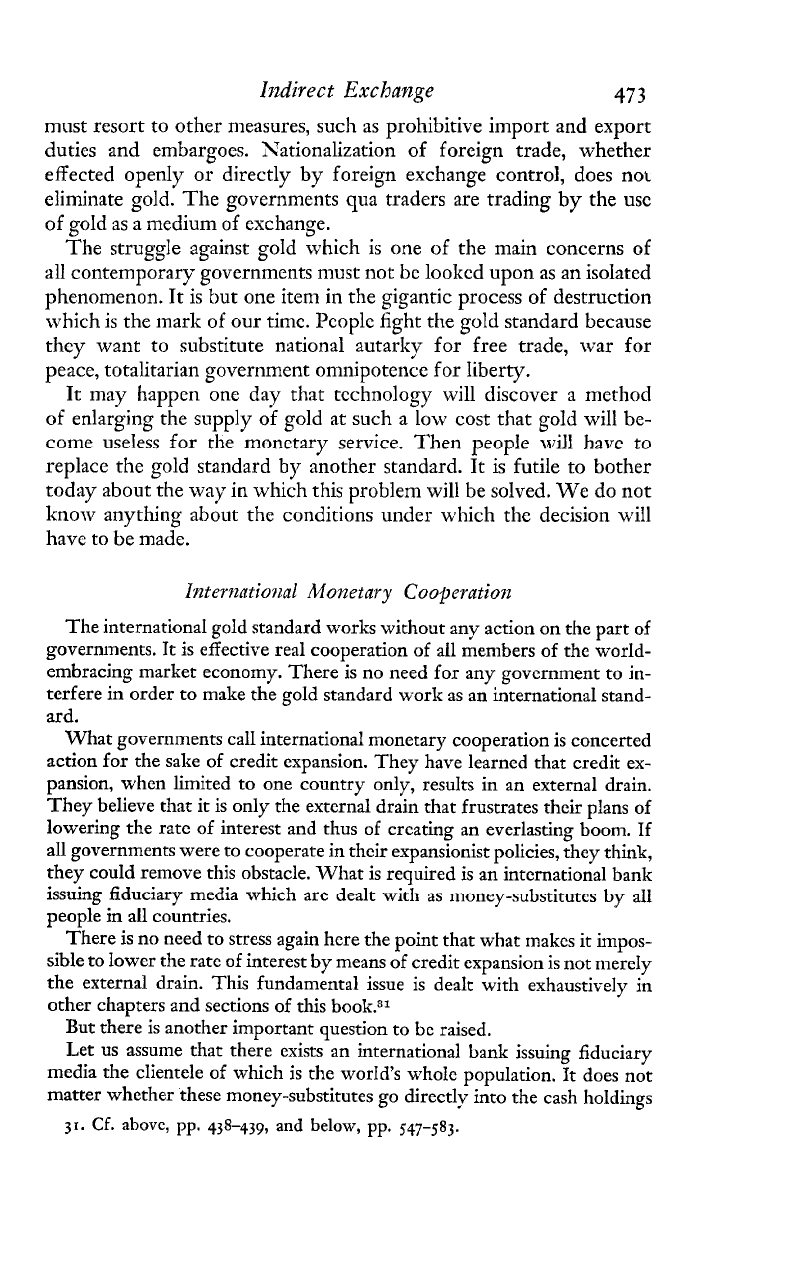
Indirect
Exchange
47
3
must resort to other measures, such as prohibitive import and export
duties and
embargoes.
Nationalization
of
foreign trade, whether
effected openly or directly by foreign exchange control, does not
eliminate gold. The governments qua tradcrs are trading by the usc
of gold as
a
medium of exchange.
The struggle against gold which is one of the main concerns of
all contemporary governments must not be looked upon as an isolated
phenomenon.
It
is but one item in the gigantic process of destruction
which is the mark of our time. People fight the gold standard because
they want to substitute national autarky for free trade, war for
peace, totalitarian government omnipotence for liberty.
It
may happcn one day that
technology
will discover a method
of enlarging the supply
if
gold at such a low cost that gold will be-
come useless for the monetary service. Then people will have to
replace the gold standard by another standard. It is futile to bother
today about the way in which this problem will be solved. We do not
know anything about thc conditions under which the decision will
have to be made.
International Monetary Cooperation
The international gold standard works without any action on the part of
governments. It is effective real cooperation of all members of the world-
embracing market economy. There is no need for any government to in-
terfere in order to make the gold standard work as an international stand-
ard.
What governments call international monetary cooperation is concerted
action for the sake of credit expansion. They have learned that credit ex-
pansion, when limited to one country only, results in an external drain.
They believe that it is only the extcrnal drain that frustrates their plans of
lowering the rate of interest and thus of creating an everlasting boom. If
all governments were to cooperate in thcir expansionist policies, they think,
they could remove this obstacle. What is required is an
international
bank
.
.
issuiTig
fibiiciary
riiedia
which
arc
dealt
with
as
money-su'ustim~es
by
aii
people in all countries.
There is no need to stress again here the point that what makes it impos-
sible to lower the ratc of interest by means of credit expansion
is
not merely
the external drain. This fundamental issue is dealt with exhaustively in
other chapters and sections of this book.31
But there is another important question to
bc
raised.
Let us assume that there exists an international bank issuing fiduciary
media the clientele of which is the world's whoIc population. It does not
matter whcther these money-substitutes go directly into the cash holdings
31.
Cf.
above, pp.
438-439,
and below,
pp.
547-583,
